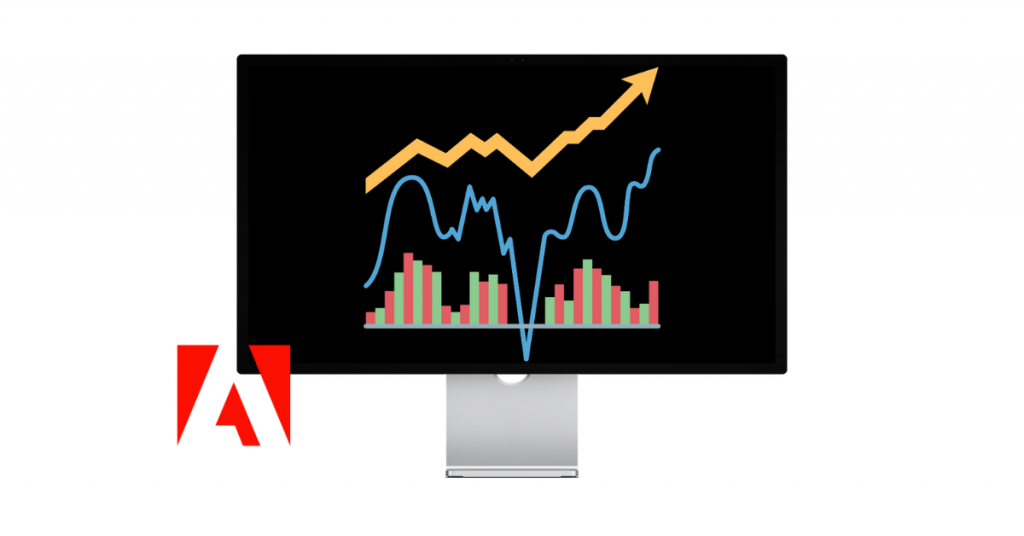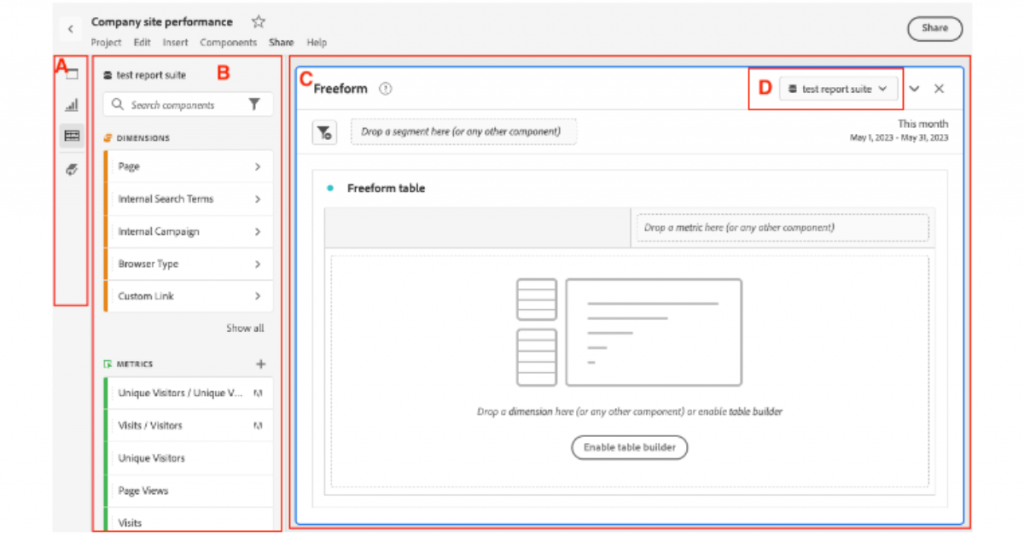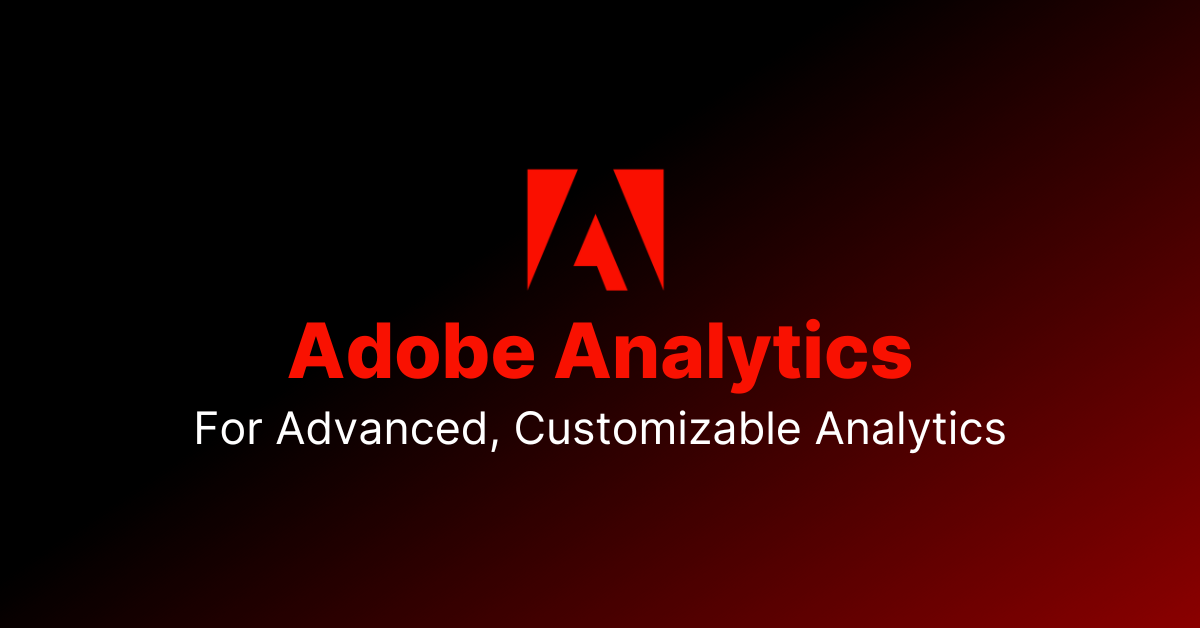In today’s data-driven world, enterprises require potent analytics tools to make informed decisions. What is Adobe Analytics used for? It’s a powerful solution that revolutionizes the way organizations understand their customer data, personalize experiences, and optimize their return on investment. It’s not just an analytics tool—it’s a game-changer.
Key takeaways
- Adobe Analytics is a powerful tool for businesses to gain insights into customer data, personalize experiences, and optimize returns.
- It provides advanced statistical models and AI features for anomaly detection, predictive analytics, and refining marketing campaigns.
- Adobe Analytics enables organizations to measure ROI from various channels, target audiences with personalized content, and use reporting & visualization features to make informed decisions.
Understanding Adobe Analytics

Adobe Analytics stands as a potent web analytics tool that helps businesses understand customer data, tailor experiences, and optimize return on investment. It’s not just about marketing analytics; Adobe Analytics also provides features for customer journey analysis, enabling users to leverage the capabilities of Analysis Workspace with analytics data from the Adobe Experience Platform. B2B companies can also benefit from Adobe Analytics to monitor website usage, evaluate lead generation, and assess the success of marketing campaigns targeting other businesses.
Businesses can leverage Adobe Analytics to enhance marketing strategies, customize email campaigns, and support data-driven decision-making. But what sets Adobe Analytics apart from other analytics tools? We will delve into its notable characteristics and the potential for integration.
Key Characteristics of Adobe Analytics
Adobe Analytics is one of the most powerful analytics tools available, providing real-time data processing, customizable segmentation, and calculated metrics for comprehensive analysis. With real-time data processing, businesses can monitor key metrics and trends in real time and generate custom visualizations using artificial intelligence. Adobe Analytics also offers powerful and flexible customization of segmentation, making analyzing data more efficient and effective.
Calculated metrics are a key feature of Adobe Analytics, generating in-depth insights and superior data visualization when used alongside other ad hoc analysis features. These characteristics make Adobe Analytics a valuable tool for businesses looking to dive deeper into their data and uncover actionable insights.
Adobe Experience Cloud integration
Adobe Analytics integrates easily with other platforms in Adobe Experience Cloud, providing a smooth user experience. This integration allows businesses to benefit from anomaly detection results combined with data visualization capabilities. Adobe Analytics employs sophisticated statistical models such as time-series analysis and machine learning algorithms to detect anomalies and identify outliers that may point to abnormal events or activities.
Integration with Adobe Experience Cloud allows businesses to tap into the potential of the entire Adobe product suite, providing an all-inclusive digital marketing and customer experience management solution. This holistic view of customer interactions across multiple channels enables companies to make data-driven decisions and optimize their marketing strategies for maximum impact.
Analyzing customer data with Adobe Analytics
Adobe Analytics excels at:
- Collecting and analyzing customer data from multiple channels
- Providing actionable insights for informed decision-making
- Optimizing marketing strategies
- Tracking customer journeys
- Improving customer experiences
- Helping organizations make sense of vast amounts of data and turn it into actionable insights.
Furthermore, Adobe Analytics offers advanced features like Flow Reports and Visualizations, which provide a visual representation of user navigation through different pages, sections, or events, allowing for the identification of areas of stagnation, abandonment, and potential optimization. To make the most of these features, it’s essential to use Adobe Analytics effectively.
We will examine how Adobe Analytics gathers and scrutinizes customer data across various channels and utilizes sophisticated statistical models and AI capabilities.
Multichannel data collection
Multichannel data collection is crucial for gaining insight into customer behavior across various touchpoints. Adobe Analytics provides powerful tools for fallout and flow analysis, allowing businesses to identify points of user attrition in a multi-step process and optimize user experiences and conversion rates.
The use of multichannel data collection enables businesses to:
- Gain a deeper understanding of the customer journey across various channels
- Fine-tune their marketing strategies based on this understanding
- Identify trends and recognize opportunities
- Make data-driven decisions that drive growth
Additionally, Adobe Analytics utilizes attribution models to assign credit or value to various marketing touchpoints throughout the customer journey, offering a total of six different attribution models to choose from.
- First and Last Model: The First and Last model is designed to understand the initial and final steps in a conversion journey. The first touch represents the initial interaction that leads to a sale, indicating the effectiveness of campaign awareness. On the other hand, the last touch showcases the final interaction before a purchase, highlighting the impact of call-to-action campaigns.
- Even Model: The Even model offers a broader perspective on marketing engagement. In this approach, every qualifying marketing interaction is given an equal share of the order and revenue resulting from the conversion. This ensures that all touchpoints, regardless of their position in the customer journey, are equally credited for their contribution.
- Starter, Player, and Closer Model: The Starter, Player, & Closer model is a nuanced approach that allocates conversion value based on the position of the interaction. For example, the first interaction, termed the starter, might be allocated 30% of the conversion revenue. The last interaction, or the closer, could also receive 30%. Meanwhile, the intermediate interactions, known as players, collectively share the remaining 40% of the value.
- Adjacency Model: The Adjacency model provides insights into the proximity of marketing channels to the conversion. It reveals the typical position of a marketing channel in the conversion journey, answering questions like whether a particular channel is usually the first, fifth, or tenth interaction leading up to a successful conversion.
- Latency Model: The Latency model is all about timing. It measures the delay or lag between a marketing interaction and the subsequent successful conversion. This model is particularly useful for differentiating between awareness and call-to-action campaigns. It also provides insights into how quickly target audiences typically respond after a specific marketing interaction.
- Pathing Model: The Pathing model delves deep into the customer’s engagement journey with various marketing channels. It’s designed to establish and understand the relationships between different marketing interactions within the overall customer journey. By exploring process maps and evaluating direct sequential marketing interactions, businesses can gain a clearer picture of their customers’ paths to conversion.
Each of these models offers a unique lens through which businesses can evaluate and optimize their marketing strategies, ensuring they effectively reach and convert their target audiences.
Advanced statistical models and AI
Adobe Analytics provides advanced statistical models and AI features, including:
- Anomaly detection—to help businesses identify trends and opportunities
- Predictive analytics—to distill valuable insights from large datasets
Anomaly detection in Adobe Analytics is enabled by advanced statistical techniques to determine whether an observation should be considered anomalous, helping businesses uncover unexpected trends and potential factors that contributed to those anomalies.
The predictive analytics feature in Adobe Analytics assists businesses by leveraging machine learning and advanced statistical modeling to analyze customer data, recognize patterns, and forecast potential behavior such as churn or conversion. This enables businesses to make decisions based on data, optimize marketing campaigns, and identify unexplored possibilities for growth.
Enhancing digital marketing strategies with Adobe Analytics
Adobe Analytics plays a pivotal role in enhancing digital marketing strategies by:
- Measuring marketing channel performance
- Providing personalization and targeting capabilities
- Evaluating marketing channel efficacy
- Employing metrics such as marketing channel instances, first and last touch metrics, and hidden Markov models
- Enabling businesses to monitor the visit and engagement data of marketing channels
- Assigning conversions to the respective channels
Adobe Analytics utilizes a multitude of data sources to enhance personalization and targeting, such as:
- Automated Personalization (AP) data, which optimizes the user experience based on behavior and preferences
- Data gathered for Adobe Target’s personalization algorithms, providing a more tailored and relevant user experience
- Integration with third-party analytics, broadening the scope of data for more comprehensive insights
We will delve next into how Adobe Analytics gauges the effectiveness of marketing channels and facilitates personalization and targeting.
Measuring marketing channel effectiveness
Assessing marketing channel effectiveness is crucial for optimizing marketing spend and improving return on investment. Adobe Analytics assesses the effectiveness of marketing channels using metrics like marketing channel instances, first and last touch metrics, along with Hidden Markov Models (HMMs). It records visit and engagement data of different channels and allocates conversions back to the respective channels. By tracking the ROI of different marketing channels, businesses can allocate their marketing budget more efficiently and improve their overall performance.
With Adobe Analytics, organizations can analyze their marketing efforts across multiple channels, identifying areas for improvement and optimizing their strategies to drive growth. This comprehensive approach to measuring marketing channel effectiveness helps businesses make data-driven decisions that lead to increased ROI.
Personalization and targeting
Personalization and targeting are essential components of a successful digital marketing strategy. Adobe Analytics facilitates customization and direction of content, products, and services according to customer data and insights. By leveraging the power of Adobe Analytics, businesses can create tailored experiences for their customers, increasing engagement and driving growth.
Adobe Analytics offers automated personalization, integration with third-party data, one-click personalization, and segmentation as features to enable personalization and targeting. By utilizing these features, businesses can better understand their customers, segment their audiences, and deliver personalized experiences that resonate with their target market. With Adobe Analytics, organizations can harness the power of customer data to create experiences that drive engagement, conversions, and, ultimately, business success.
Reporting and visualization features

Adobe Analytics offers the following features:
- Powerful reporting and visualization capabilities for easy data analysis and interpretation
- Flexible and user-friendly interface for creating custom reports and visualizations tailored to unique needs
- Access to a wealth of data and insights for making data-driven decisions
- Ability to improve overall performance
We will examine the Analysis Workspace feature and discuss how custom variables and cohort analysis can assist businesses in gaining a deeper understanding of customer behavior and trends.
Analysis Workspace feature
Analysis Workspace is a powerful feature in Adobe Analytics that enables users to:
- Create tailored analysis projects with drag-and-drop data tables, visualizations, and components
- Customize the platform for data analysis
- Easily explore and manipulate data
- Enhance understanding of customer behavior and trends
This data analytics tool is designed to help businesses make informed decisions by enabling them to analyze data effectively.
Adobe Analytics offers various data visualizations, such as:
- Bar charts
- Line charts
- Pie charts
- Cohort tables
- Bullet graphs
- Histograms
- Maps
These visualizations allow users to create visually appealing and informative reports. By leveraging Analysis Workspace, businesses can gain valuable insights into their customers and make data-driven decisions that drive growth and success.
Custom variables and cohort analysis
Custom variables and cohort analysis provide businesses with the ability to gain further insight into customer behavior and trends. Cohort analysis in Adobe Analytics is a segmentation method for analyzing user data over a period of time. It involves classifying visitors to your website or app based on common characteristics or behavior. This approach allows businesses to:
- Track customer behavior
- Identify trends
- Optimize their marketing strategies
- Improve overall performance
Cohort Analysis can be used to:
- Initiate campaigns aimed at prompting specific actions
- Allocate marketing funds precisely within the customer journey
- Identify optimal points to conclude trials or offers for maximum value
- Generate insights for A/B testing, including pricing adjustments and upgrade paths
Adobe Analytics also offers custom variables and events, which are user-defined data points that can be used to capture and track relevant user interactions or attributes. By employing custom variables and cohort analysis, businesses can dive deeper into their data and uncover actionable insights that drive growth and success.
Real-world applications of Adobe Analytics
Adobe Analytics has a broad range of real-world applications, including eCommerce and retail, media and entertainment, and various other industries. Its powerful features and advanced analytics capabilities enable businesses to make data-driven decisions, improve customer experiences, and drive growth.
Adobe Analytics offers a holistic solution for eCommerce and retail businesses, allowing them to scrutinize and quantify diverse aspects of their online performance. It enables businesses to gain insights into:
- Website traffic
- Conversion rates
- Customer segmentation
- Product performance
This helps them to understand user behavior, track customer journeys, and optimize marketing strategies. With Adobe Analytics, businesses can make data-driven decisions, improve customer experiences, and drive growth in the online retail space.
By leveraging the power of Adobe Analytics, eCommerce and retail businesses can optimize their online presence, increase conversions, and gain a competitive edge in the rapidly evolving digital landscape.
Choosing between Adobe Analytics and Google Analytics
In deciding between Adobe Analytics and Google Analytics, businesses ought to weigh factors like data maturity, the scale of the company, and the industry they operate in. While Google Analytics is easy to start with and requires little knowledge of data reporting, Adobe Analytics is more suitable for established companies with a clear vision of what they wish to accomplish with their data.

Google Analytics 4
Google Analytics 4 (GA4) is the latest iteration of Google’s analytics tool, designed to unify app and web analytics. It’s built with machine learning at its core, enabling users to understand customer interactions across various touchpoints and predict trends such as churn rates or potential revenue from certain segments. GA4 is known for its event-based tracking, real-time data analysis, and deep integrations within the Google ecosystem. It’s also privacy-centric, aiming to remain robust amidst tightening privacy legislation. For many, GA4’s free-to-use model is a strong starting point, offering a user-friendly interface with pre-made reports and a customizable dashboard.
Adobe Analytics
Adobe Analytics is geared more towards larger enterprises. It offers a comprehensive view of the customer journey, integrating data from various online and offline channels. Adobe Analytics excels in its depth of analysis, allowing for detailed reports on web behavior, marketing analytics, and predictive insights using advanced machine learning techniques. Unlike GA4, Adobe Analytics does not come with pre-made reports, requiring a higher level of data maturity to build and interpret custom reports.
The main differences between the two platforms can be summarized as follows:
- Pricing: GA4 is free until certain limits are reached, after which you would need to upgrade to Google Analytics 360. Adobe Analytics comes with a cost from the outset, targeting enterprise-level users.
- Ease of use: GA4 offers a more accessible entry point with ready-made reports and a simpler setup. Adobe Analytics, while more complex, provides a richer set of features for data analysis.
- Customization and reporting: Both platforms offer customizable reporting capabilities, but Adobe Analytics provides a more flexible environment for creating complex reports.
For organizations at the onset of their data journey or those with basic reporting needs, Google Analytics 4 stands as a robust option. Its ease of setup and capability to furnish ample insights make it a fitting choice for numerous businesses. Conversely, organizations requiring deeper data analysis and possessing the resources to manage a more complex tool may find Adobe Analytics to be more suitable. It’s not unusual for businesses to use both platforms in tandem, leveraging GA4 for a high-level view and Adobe Analytics for granular analysis. The decision ultimately hinges on the specific business needs and the intended use of data in shaping marketing strategies.
Summary
Adobe Analytics is a powerful, comprehensive, and flexible analytics tool that empowers businesses to make data-driven decisions, optimize marketing strategies, and improve customer experiences. With features such as multichannel data collection, advanced statistical models, AI capabilities, and seamless integration with the Adobe Experience Cloud, Adobe Analytics is the ideal solution for businesses looking to gain a competitive edge in today’s digital landscape. So, gear up and harness the power of Adobe Analytics to revolutionize your digital marketing strategies and drive growth.
Frequently Asked Questions
What does Adobe Analytics do?
Adobe Analytics is a robust platform that offers comprehensive reporting, intricate visualizations, and in-depth analysis of customer data. It empowers businesses to uncover actionable insights, seamlessly integrate data from every digital touchpoint in the customer journey, and harness predictive intelligence to enhance customer experiences.
Is Adobe Analytics a reporting tool?
Yes, Adobe Analytics is a reporting tool. It’s part of the Adobe Experience Cloud suite of products and provides advanced analytics capabilities for businesses. Adobe Analytics allows users to collect, analyze, and report on website and app data to gain insights into user behavior and optimize their digital marketing strategies. It offers a variety of features for custom data analysis, segmentation, and visualization, enabling organizations to create detailed reports and dashboards tailored to their specific needs.
Who uses Adobe Analytics?
Adobe Analytics is used by a diverse range of professionals in medium to large enterprises, including marketers, data analysts, product managers, and executives, who require in-depth analysis of customer data to inform strategy, optimize user experience, and drive data-driven decision-making across various digital channels.
What is the difference between Adobe Analytics and Google Analytics?
Adobe Analytics offers advanced, customizable analytics suited for large enterprises requiring detailed data integration, while Google Analytics provides user-friendly, pre-configured reporting ideal for small to medium businesses seeking straightforward insights. Adobe emphasizes comprehensive data analysis, whereas Google caters to accessibility and ease of use with a freemium model.
What is the use of Adobe Analytics?
Adobe Analytics is used for collecting, analyzing, and reporting on website and app data to understand customer behavior and optimize digital marketing efforts. Its advanced capabilities allow for deep dives into user interactions, enabling businesses to segment audiences, track and predict customer journeys, and personalize experiences, ultimately driving better business decisions and enhancing performance across digital platforms.
Unlock the power of Adobe Analytics to elevate your data insights and drive smarter business decisions. Interested in advancing your analytics? Contact us to explore the possibilities with Adobe Analytics.


Share on: